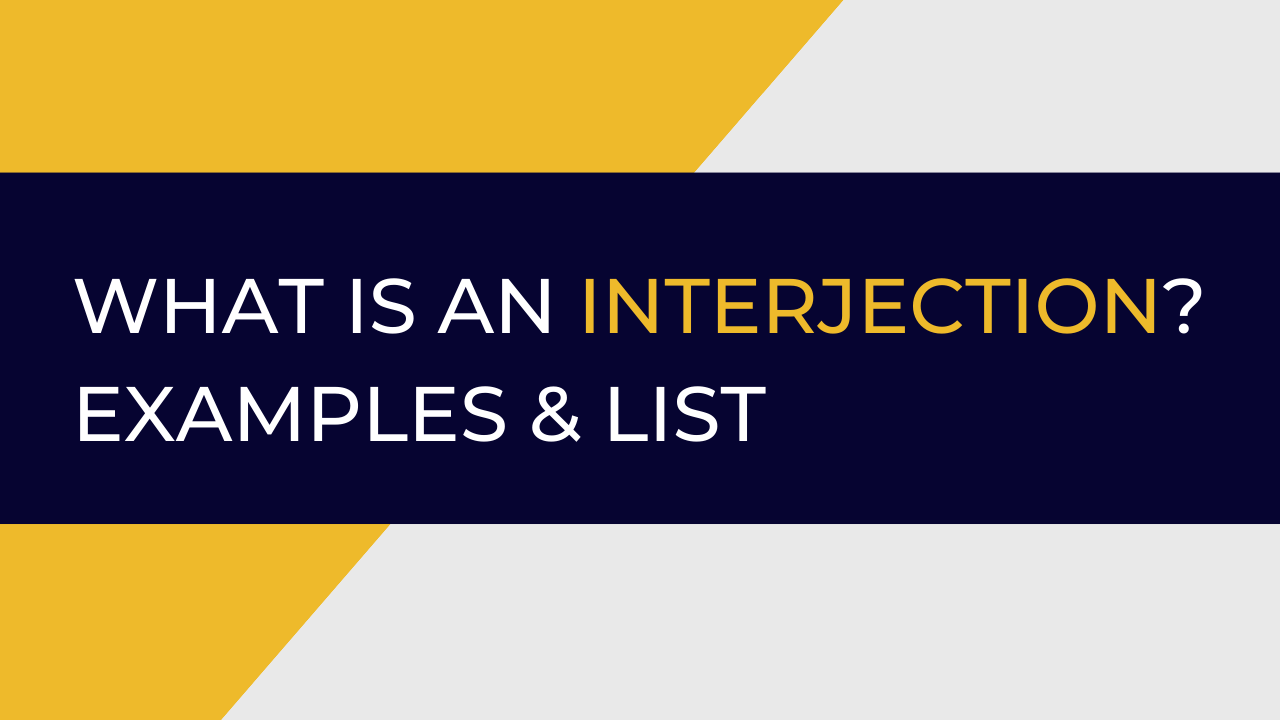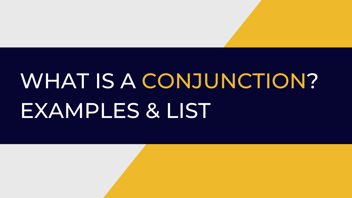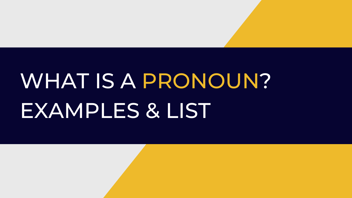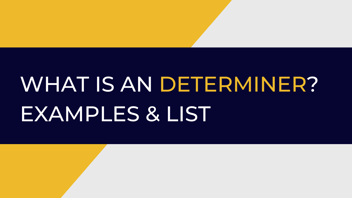What is an Interjection? Definitions, Examples, and Comprehensive List
As a writing coach and ghostwriter who’s helped over 130 clients refine their voice, I’ve learned that it’s often the smallest words that make the biggest emotional impact.
You can build beautiful sentences with vivid verbs and poetic adjectives, but without the right emotional punctuation — the kind that mimics natural speech — your writing can still fall flat. That’s where interjections come in.
Interjections are among the most overlooked tools in a writer’s toolbox. Yet they play a critical role in making your writing feel human, relatable, and emotionally alive. In this article, I’ll walk you through what interjections are, show you how to use them effectively, and give you a categorized list to reference anytime you want to elevate your tone, whether you're writing dialogue, email copy, or brand content.
What Is an Interjection?
An interjection is a word or phrase used to express strong emotions or spontaneous reactions. Interjections are grammatically independent — meaning they don’t serve a direct grammatical purpose in the sentence — but they add vital emotional context, tone, or immediacy.
You’ve heard them a thousand times in conversation: Wow!, Ouch, Hmm…, Yikes! These small bursts of expression punctuate our everyday speech, and when used intentionally in writing, they bring energy, rhythm, and relatability to the page.
There are two main categories of interjections:
-
Primary interjections are words that only function as interjections. Examples: Yay!, Oops!, Uh-oh.
-
Secondary interjections are words that have other grammatical uses but can act as interjections in the right context. Examples: Heavens!, Damn!, Well…
Interjections are also often categorized based on what they express. These include emotive interjections (feelings), volitive interjections (commands or requests), and cognitive interjections (thoughts or realizations). We’ll explore each of these in detail shortly.
Think of interjections as the sparks in your writing — they may not carry grammatical weight, but they carry emotional charge.
In short, interjections are not structurally necessary to a sentence, but they’re often essential for authentic, expressive writing. Especially in informal writing, interjections help your words sound more human and less robotic — a key trait in copywriting, personal branding, and storytelling.
Why Writers Should Care About Interjections
Most writers obsess over sentence structure, tone, and vocabulary — and rightly so. But in the process, many overlook the small, emotionally charged words that make writing feel alive. As someone who's ghostwritten books and branding for over 130 clients, I’ve seen firsthand how one well-placed interjection can completely shift a reader's emotional response.
Interjections may not add information, but they add intention. They signal how the writer or speaker feels, which helps the reader interpret not just the words, but the emotional weight behind them. That’s critical in any writing that aims to connect: think marketing emails, sales pages, thought leadership posts, and especially dialogue.
Imagine a character saying:
“I can’t believe you did that.”
Now imagine them saying:
“Whoa — I can’t believe you did that!”
The second version is far more believable and emotionally resonant. That’s the power of a well-chosen interjection.
Interjections Make Your Writing Sound Human
When you’re aiming for natural tone — especially in informal writing — interjections help mimic the rhythm of casual speech. They break the formality of textbook-sounding sentences and invite the reader into a more personal, conversational space.
This is particularly useful in:
-
Personal essays and social media posts
-
Dialogue in fiction or scripts
-
Sales copy and brand storytelling
-
Emails and direct communications
If your writing feels stiff, flat, or overly polished, a strategic interjection can immediately loosen it up and bring in some humanity.
The Subtle Art of Persuasion
Interjections also influence how your audience feels while reading. They can cue urgency (“Uh-oh…”), excitement (“Yes!”), relief (“Phew.”), or even discomfort (“Ew.”). And the best part? They do it instantly — no need for elaborate explanation.
In persuasive writing, where tone and emotional resonance matter more than technical perfection, this is gold. Your job isn’t just to inform — it’s to evoke. Interjections are among the fastest ways to do that.
The 4 Types of Interjections (with Examples)
Interjections may look simple on the surface, but they’re surprisingly diverse. Understanding the different types of interjections helps you use them more deliberately — not just as filler, but as a precise tool to shape tone, emotion, and character.
Let’s explore the four main categories of interjections, each with examples and use cases.
1. Primary Interjections
Primary interjections are standalone words that serve no other grammatical function — they exist solely to express emotion. These are what most people think of when they hear the word “interjection.”
Examples:
-
Wow! (surprise or admiration)
-
Ouch! (pain)
-
Yay! (joy or celebration)
-
Oops! (acknowledgment of a mistake)
-
Uh-oh. (realization of trouble)
These are the most direct way to express strong emotion quickly. Writers often use them to mirror casual speech and create a vivid, expressive tone in dialogue or informal writing.
2. Secondary Interjections
Secondary interjections are words or phrases that originally belong to other parts of speech but function as interjections in emotional contexts. They're more nuanced and often rooted in cultural or idiomatic usage.
Examples:
-
Heavens! (surprise or shock)
-
Damn. (frustration or anger)
-
Well… (hesitation or transition)
-
Goodness! (surprise or dismay)
-
Jeez. (mild annoyance or disbelief)
Because they come from other parts of speech, these interjections add a layer of subtlety to the emotional expression. They're perfect when you want tone without being overly dramatic.
3. Volitive Interjections
Volitive interjections are used to express commands, requests, or calls for action. They show the speaker’s will or desire and often mimic spoken cues.
Examples:
-
Shh! (request for silence)
-
Hey! (call for attention)
-
Go! (command to act)
-
Stop! (urgent directive)
-
Look! (request to observe)
These are especially powerful in dialogue, scripts, or calls to action in copywriting. They’re short, punchy, and demand immediate attention.
4. Cognitive & Emotive Interjections
These two subcategories express internal states:
-
Cognitive interjections reflect thoughts, realizations, or hesitation.
-
Emotive interjections reflect spontaneous feelings and emotional reactions.
Cognitive Interjections Examples:
-
Hmm… (thinking or uncertainty)
-
Er… (hesitation)
-
Uh… (searching for words)
-
Huh? (confusion or questioning)
Emotive Interjections Examples:
-
Phew! (relief)
-
Aww. (affection or sympathy)
-
Ew! (disgust)
-
Yikes! (alarm or fear)
These interjections bring readers closer to the character or narrator’s thought process, making the writing more immersive. In branding, they’re great for making content sound more human and spontaneous.
Interjections in Action: Before-and-After Writing Examples
Knowing what interjections are is one thing — but seeing them in action is where the real magic happens. When used purposefully, interjections bring emotion, pacing, and realism into your writing. They make your content feel more like natural speech and less like a lecture.
Let’s look at how adding interjections can instantly change the tone and impact of your writing.
Example 1: Flat vs. Expressive Writing
Without interjections:
This is awkward. I’m not sure why we’re doing this. Oh, now I remember. It’s my sister’s birthday. I hope it’s a good one. Wait, I forgot to get her a present. Maybe I can go to the mall. I have to leave now.
This version delivers the message — but it feels stiff, mechanical, and emotionally dry.
With interjections:
Erm, this is super awkward. Why are we doing this? Oh, right — it’s my little sister’s birthday. Yay! This one’s going to be fantastic. Wait… I forgot to get her a gift. Uh-oh. Maybe I still have time to hit the mall. My God, I’ve gotta go now!
The second version pops. The interjections inject emotion, urgency, and personality. You can almost hear the speaker’s voice.
Example 2: Brand Voice in Copywriting
Without interjections:
Our new platform is ready. Sign up today and explore our features. We’re excited to have you on board.
With interjections:
Guess what? Our new platform is finally here! Yep, it’s ready — and waiting for you. Sign up today and boom, you’re in. We can’t wait to see what you create!
See the difference? Interjections create tone. They soften the sales pitch and make the message feel like a conversation, not a command.
Why This Works
Interjections:
-
Break up rhythm and add sentence variety
-
Make writing feel authentic and emotionally alive
-
Trigger the reader’s own reactions by modeling natural emotional cues
In my work with clients, I’ve often found that a lack of interjections is a sign the writing is too “safe” — polished, but bland. Adding just a few well-placed interjections can bring back the writer’s actual voice. It’s like adding seasoning to a dish: subtle, but transformative.
When to Use (and Not Use) Interjections
Interjections are powerful — but like any strong writing tool, they only work when used in the right context. Use them well, and your writing gains voice, rhythm, and emotion. Use them poorly, and it starts to feel unprofessional or juvenile.
Let’s break down when interjections work, and when you should hold back.
When to Use Interjections
1. Informal Writing
Blog posts, newsletters, social captions, personal essays — these are prime places for interjections. They add casual tone, playfulness, and emotional presence, which is exactly what readers want in these formats.
“Uh-oh, looks like your email list hasn’t heard from you in weeks…”
2. Dialogue in Fiction or Scripts
Real people don’t speak in perfectly structured sentences. They react. Interjections like huh, ouch, ew, or phew make character dialogue believable and human.
“Ew. I’m not touching that.”
3. Persuasive or Conversational Copywriting
In sales and brand storytelling, emotion sells. Interjections inject authenticity, especially when you want to sound like a real person — not a corporate brochure.
“Psst — have you seen our Black Friday deal?”
4. Creative Nonfiction and Memoir
If you're telling a story with emotional depth or humor, interjections can help deliver the feeling behind the facts.
“Boom. Just like that, my five-year plan was toast.”
When Not to Use Interjections
1. Formal Writing
Academic essays, legal documents, technical writing, or formal business reports don’t typically allow room for expressive outbursts.
❌ “Wow! The legal precedent is clearly in favor.”
✅ “The legal precedent clearly supports the ruling.”
2. Overuse Within a Short Span
Too many interjections in a row can feel cartoonish or distracting. They should be used for punctuation, not padding.
❌ “Wow! Yay! Oops! Dang! Yikes!”
✅ “Wow — I wasn’t expecting that. Oops, my bad.”
3. Mismatched Tone or Audience
Using Yippee! in a serious op-ed or Ew in a brand campaign for luxury watches can undermine your credibility. Always consider the emotional intelligence of your audience.
A Note From the Coaching Chair
When I edit client work, I often see interjections used either too sparingly or too playfully — both extremes can hurt the writing. My rule of thumb?
Use interjections when they enhance tone and match the moment. If they don't do either, cut them.
Think of them like emojis in professional communication. Used occasionally, they can warm up the tone. Used too often, they start to dilute the message.
Punctuation Tips for Interjections
Interjections may be short, but punctuation gives them their power. A single interjection can express excitement, sarcasm, fear, or confusion — if it's punctuated correctly.
As a writing coach, I always tell my clients: you can say the same word three ways, and mean three different things. That’s the subtle (and often overlooked) role of punctuation in emotional clarity.
Here’s how to punctuate interjections for maximum effect.
1. Use Exclamation Points for Strong Emotion
If the interjection is full of excitement, shock, urgency, or pain, it usually calls for an exclamation point.
Examples:
-
Wow! That was incredible.
-
Ouch! That really hurt.
-
Yay! We did it!
But beware of overuse. Too many exclamations can come off as juvenile or overly dramatic — especially in professional writing. Use them intentionally.
2. Use Commas for Milder Emotion or Pause
If the interjection is softer — expressing hesitation, transition, or a light reaction — use a comma to blend it into the sentence.
Examples:
-
Well, I’m not sure about that.
-
Hmm, I guess you’re right.
-
Oh, I didn’t realize that.
This is common in dialogue or narrative writing where tone shifts subtly rather than abruptly.
3. Use Question Marks for Uncertainty or Confusion
Some interjections express doubt or surprise — and end with a question mark to signal that uncertainty.
Examples:
-
Huh? What did you say?
-
Eh? Is that really true?
-
What?! You’re moving where?
This punctuation often signals confusion, disbelief, or a need for clarification.
4. Standalone or Embedded: Both Work
Some interjections work best as standalone sentences — especially strong emotional reactions.
Uh-oh. That doesn’t look good.
Yikes! That escalated quickly.
Others blend seamlessly into the sentence, often followed by a comma or ellipsis.
Well... I suppose we could try.
Hmm, maybe we’re overthinking this.
Bonus Tip: Match the Punctuation to the Emotion
| Emotion | Interjection | Punctuation |
|---|---|---|
| Surprise | Wow | ! |
| Confusion | Huh | ? |
| Hesitation | Um, Well | , or … |
| Disgust | Ew | ! or . |
| Excitement | Yay | ! |
Your punctuation doesn’t just clarify the meaning — it amplifies it. Use it as your emotional compass.
Interjection Examples by Emotion or Use Case
To make interjections easy to apply, it helps to organize them by the kind of emotion or action they’re meant to express. Whether you're writing character dialogue, casual copy, or a playful social caption, this breakdown will help you pick the right word — fast.
Each group below reflects a typical emotional or conversational use case, and the examples are some of the most common (and useful) interjections in the English language.
Greetings
Used to open a conversation or get someone’s attention.
-
Hi
-
Hey
-
Hello
-
Howdy
Example:
Hey, how have you been?
Joy and Celebration
Used to express happiness, excitement, or enthusiasm.
-
Yay!
-
Yippee!
-
Hurray!
-
Woohoo!
-
Yahoo!
Example:
Yippee! I got the job!
Approval and Praise
Used to congratulate or show admiration.
-
Bravo!
-
Congrats!
-
Well done!
-
Good job!
-
Amen!
Example:
Bravo! That was an amazing performance.
Surprise or Shock
Used when something unexpected happens.
-
Wow!
-
Gosh!
-
Dang!
-
Whoa!
-
What?!
Example:
Whoa! I didn’t see that coming.
Pain, Discomfort, or Disgust
Used to react to physical or emotional discomfort.
-
Ouch!
-
Ow!
-
Ugh!
-
Ew!
-
Yikes!
Example:
Ugh, that smells terrible.
Farewell or Departure
Used when leaving or ending an interaction.
-
Bye
-
Goodbye
-
Farewell
-
See ya
-
Later!
Example:
See ya! I’ll text you later.
Doubt or Hesitation
Used to express uncertainty or a pause in thought.
-
Hmm...
-
Uh...
-
Er...
-
Well...
-
Um...
Example:
Hmm... I’m not so sure about that.
Volitive or Commands
Used to direct, warn, or call for attention.
-
Shh!
-
Hey!
-
Stop!
-
Look!
-
Go!
Example:
Shh! They’re about to start.
Realization or Thought Process
Used to convey cognitive response or recognition.
-
Oh!
-
Aha!
-
Huh?
-
Eh?
-
Uh-oh!
Example:
Uh-oh, I forgot my keys again.
A Note on Tone
Some interjections can work across multiple categories depending on tone and context. For example:
-
Oh! (surprise, realization, or disappointment)
-
Well... (hesitation, sarcasm, or transition)
-
Wow! (amazement, sarcasm, or shock)
This is why understanding emotive nuance is key — and one of the things I coach clients on all the time. The same word can energize or undermine your writing depending on how it’s used.
Comprehensive List of 50+ Common Interjections
To make your writing more expressive and emotionally resonant, it helps to have a broad set of interjections ready to use. Below is a comprehensive list of over 50 common interjections, including primary, secondary, emotive, cognitive, and volitive types.
These interjections are used in casual speech, informal writing, and dialogue, and many can be adapted for brand voice, storytelling, or copywriting.
Many of the interjections below are wrapped in bold tags to help with SEO and scanability — feel free to format them accordingly in your CMS.
General Use Interjections
Wow
Oh
Yes
No
Yay
Oops
Ugh
Yikes
Ouch
Huh
Eh
Hmm
Hi
Hey
Hello
Bye
Goodbye
Aw
Well
Dang
Joy & Excitement
Yippee
Woohoo
Hurray
Yahoo
Whee
Yah
Aha
Woot
Pain, Disgust, or Discomfort
Ouch
Ow
Ugh
Ew
Ack
Bleh
Gross
Surprise & Realization
Whoa
Oh no
Uh-oh
Egad
Gosh
My God
Goodness
Approval, Praise, or Agreement
Bravo
Congrats
Amen
Right on
Hallelujah
Yes!
Ok
Okay
Yep
Sure
Doubt, Hesitation, or Thought Process
Er
Um
Uh
Hmm
Well
Gee
Phew
Hmmph
Commands or Calls to Action
Shh
Look
Go
Stop
Listen
Duck!
Come on!
Quirky or Fun Interjections (Optional, for personality-packed writing)
Bam
Boom
Zoinks
Zing
Shucks
Drat
D’oh
Zounds
Pshaw
Oink
Quack
Pro tip: Use interjections sparingly but strategically. Sprinkle them where emotion peaks — not where logic is doing the heavy lifting.
Related Writing Techniques to Pair With Interjections
While interjections can dramatically enhance tone and emotional clarity, their power multiplies when combined with other smart writing strategies. To get the most out of interjections, you want them to work in concert with how your writing flows, feels, and sounds.
Here are five techniques that pair beautifully with interjections — and why I teach them consistently in my coaching and ghostwriting work.
1. Tone of Voice
Your tone of voice shapes how the reader perceives your intent — confident, casual, sarcastic, serious, playful, or professional. Interjections help amplify that tone.
Compare:
“Well, I guess that’s one way to do it.” (dry/sarcastic)
“Yay! That’s exactly what I was hoping for!” (excited/playful)
Pair interjections with consistent tone choices in verbs, punctuation, and sentence structure to maintain voice integrity.
2. Sentence Variety
Short sentences, long sentences, fragments — varying your sentence length keeps writing dynamic. Interjections fit perfectly into this rhythm, often acting as sentence starters or emotional beats.
“Whoa. That escalated quickly.”
“Okay, here’s the deal…”
“Huh? You’re serious?”
Use them to break up long paragraphs or add a pause for effect.
3. Onomatopoeia
This literary device uses words that imitate sounds — and often overlaps with interjections.
Bam!
Crash!
Buzz!
Splat!
Pairing interjections with onomatopoeia can enhance descriptions, especially in action scenes, comics, or informal storytelling. It creates sensory immersion.
4. Dialogue Techniques
Realistic dialogue doesn’t just share information — it reveals personality and emotion. Interjections mimic real speech and help you break away from overly polished or robotic dialogue.
“Um… I don’t think that’s a good idea.”
“Phew. That was close.”
“Yikes! What happened here?”
I often coach fiction and memoir writers to read dialogue out loud — if it feels flat, chances are it’s missing those natural spoken moments. Interjections fix that fast.
5. Strategic Punctuation
As we explored earlier, punctuation isn't just technical — it’s emotional. Interjections need the right punctuation to clarify the feeling behind them. Exclamation points, ellipses, question marks, and commas all contribute to how your reader hears the word.
Yes! (Excitement)
Yes... (Reluctance)
Yes? (Confusion or confirmation)
Pair interjections with tone-matching punctuation to create subtle shifts in mood or attitude.
Bonus: Don’t Forget Sentence Fragments
Another underrated partner of interjections? The intentional sentence fragment.
“Uh-oh. This isn’t good.”
“Yikes. That could’ve gone better.”
“Wow. Just… wow.”
These fragments mimic thought or speech patterns, making your writing more relatable — especially in email, copywriting, or narrative storytelling.
Common Mistakes to Avoid
Even though interjections are simple in form, they can trip up even experienced writers when used carelessly. As someone who’s reviewed hundreds of drafts for clients, I often see interjections either misused or misunderstood — which ends up hurting tone, clarity, or reader trust.
Here are the most common mistakes to avoid when using interjections in your writing:
1. Overusing Interjections
Interjections lose their punch when they appear in every sentence. If everything is “Wow!” or “Yay!”, the emotional tone starts to feel artificial or immature.
✘ “Yay! I finished the task! Woohoo! Now I can rest! Yay again!”
✔ “Yay! I finished the task. Time to rest.”
Use them like seasoning, not the main dish.
2. Using the Wrong Tone for the Audience
Using “Yippee” in a legal memo? Or “Dang” in a job application? Interjections must match both the audience and the context.
✘ “Oops! We forgot your refund.”
✔ “We’ve corrected the issue and issued your refund.”
Before you insert an interjection, ask: Would my reader actually say this in this situation?
3. Mixing Formal and Informal Voice
Don’t throw a casual interjection into an otherwise formal piece unless you’re doing it intentionally (and sparingly) for contrast.
✘ “Therefore, in conclusion, we recommend adopting the proposal. Yay!”
✔ “Therefore, in conclusion, we recommend adopting the proposal.” (No interjection needed)
Interjections belong in informal, emotive, or narrative contexts. Use them to support a conversational tone — not fight against it.
4. Repeating the Same Interjection
Using “Wow” three times in one paragraph? That’s a missed opportunity for emotional variety.
✘ “Wow! That’s huge. Wow, I had no idea. Wow, let me process that.”
✔ “Whoa! That’s huge. I had no idea. Dang, let me process that.”
Build your interjection vocabulary — refer to the list above to keep things fresh.
How I Coach Writers to Use Interjections (and Why It Works)
In working with over 130 authors, professionals, and brand storytellers, I’ve noticed something interesting: many people write the way they think they should — not the way they actually speak.
And that disconnect can cost them readers.
One of the simplest fixes? Teaching them how to use interjections.
The Problem: Polished but Emotionally Flat Writing
A client once came to me with beautifully structured chapters — great ideas, great logic — but the tone felt stiff. There was no warmth, no vulnerability, no emotional entry point. So I asked:
“How would you say this out loud to someone you trust?”
They rewrote the same paragraph using a few natural interjections — and suddenly, it sounded like them. The result? A voice that connected.
Interjections Help Writers Find Their Actual Voice
When I coach writers on tone and personality, I often recommend a light sprinkling of interjections to:
-
Break monotony
-
Signal shifts in energy
-
Make abstract ideas more visceral
-
Create conversational flow
We’re not just writing words. We’re creating a feeling. And interjections shortcut the emotional process for the reader.
Why It Works
-
Interjections are fast emotional signals: they work instantly
-
They reflect spoken rhythm, which increases readability
-
They add relatability, especially in thought leadership and personal content
Most importantly, they give writers permission to be less polished and more authentic. And authenticity? That’s what turns readers into fans.
Final Thought: The Small Words That Say So Much
Interjections are often dismissed as “fluff” — throwaway words, filler, emotional noise. But as we’ve seen, they’re anything but.
These small, spontaneous expressions carry massive emotional weight. They help you break through robotic tone, inject rhythm into your writing, and build a direct line between your thoughts and your reader’s reactions. Whether you’re writing copy, dialogue, emails, or essays, interjections offer a fast track to human connection.
If you want your writing to resonate — not just inform — these are the words you can’t afford to overlook.
So the next time your writing feels too stiff, flat, or distant, try this:
Add just one interjection.
Hmm. Maybe even two.
You’ll be surprised how much closer you’ll feel to your own voice — and how much more your audience will feel it too.
If you’re ready to truly find your voice — Book a private writing consultation and let’s make your words sound as good as your ideas.
-png.png)




